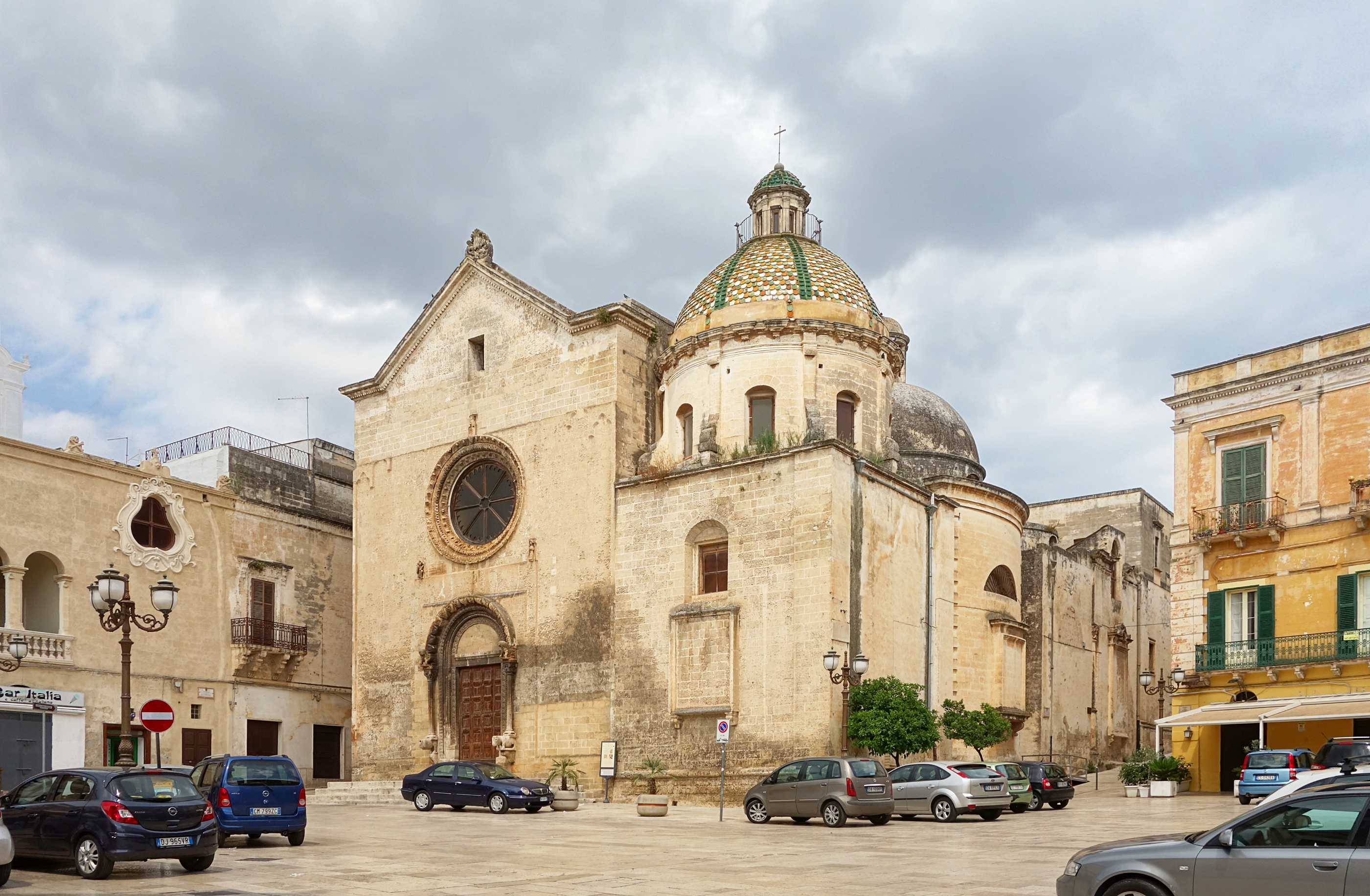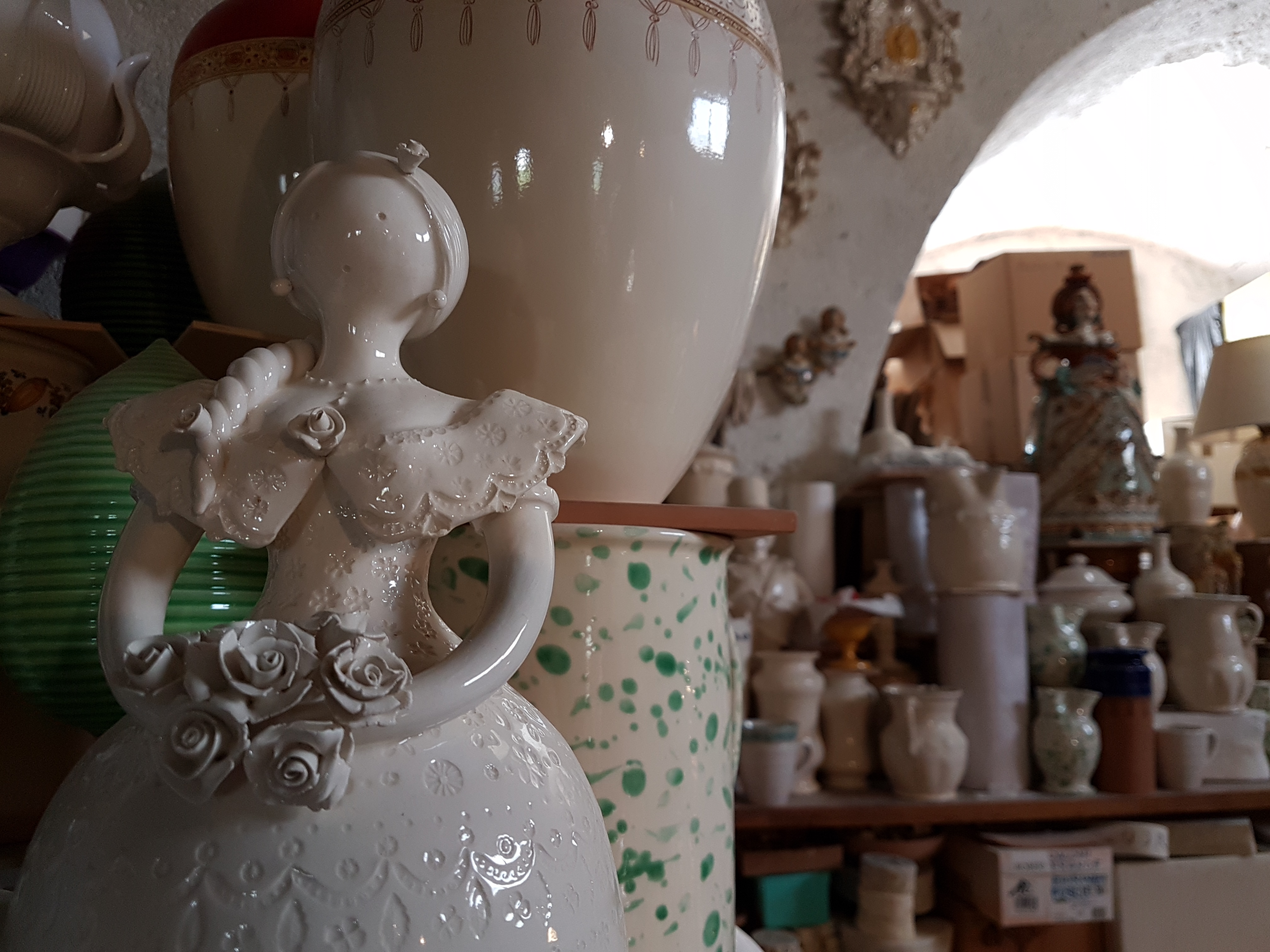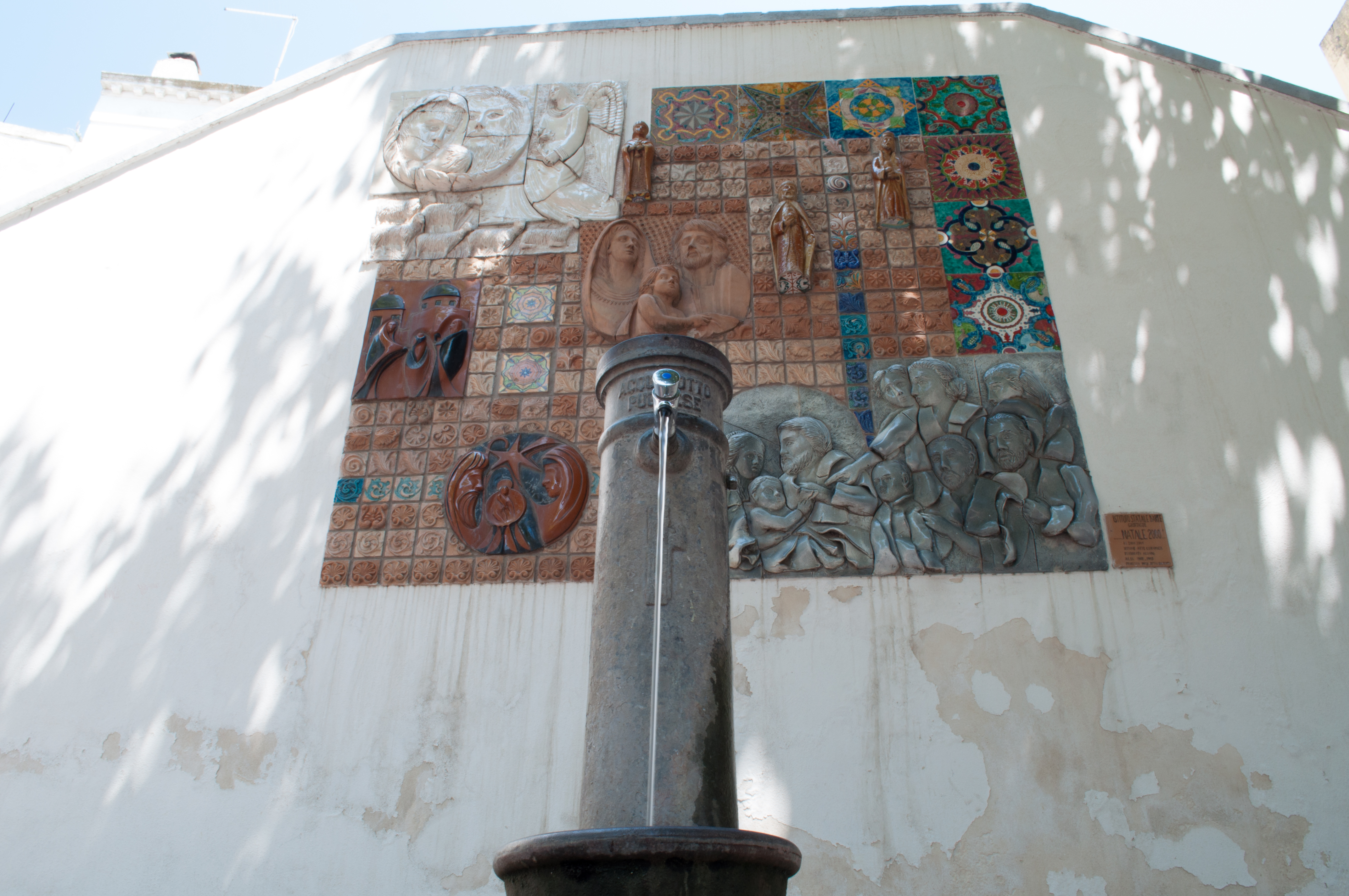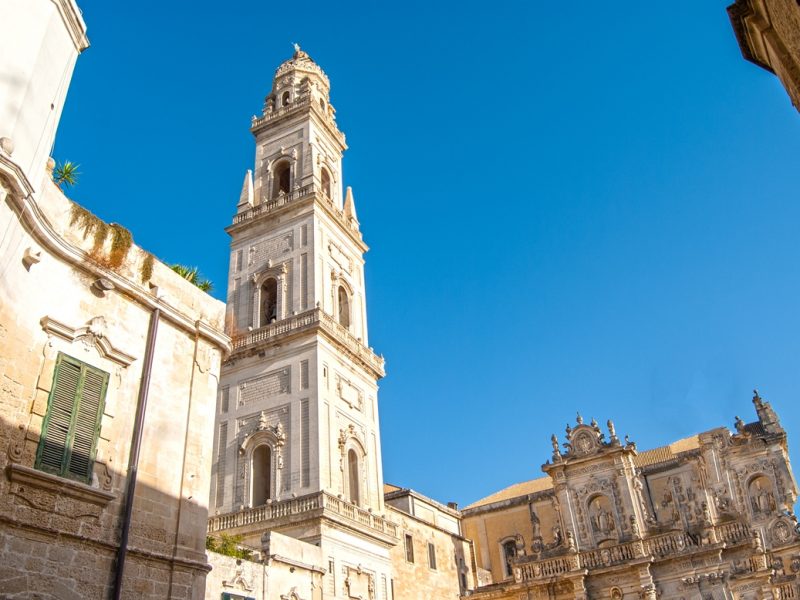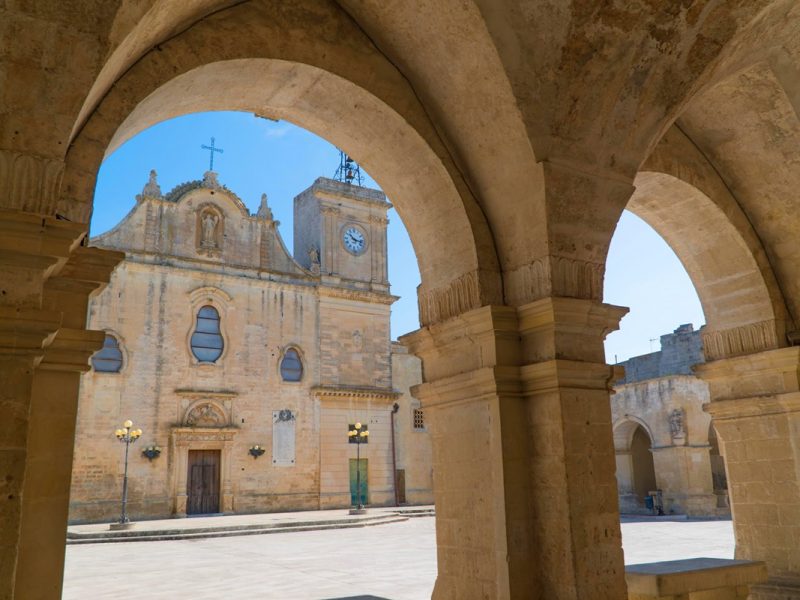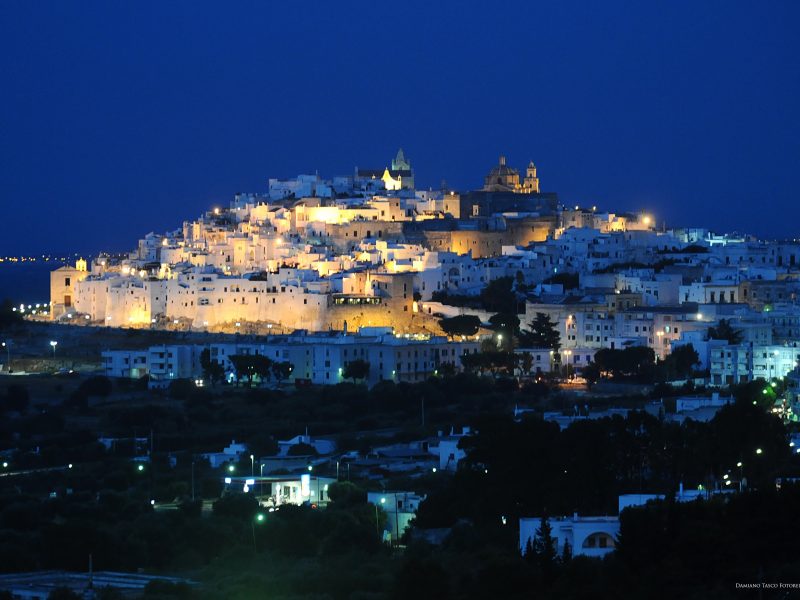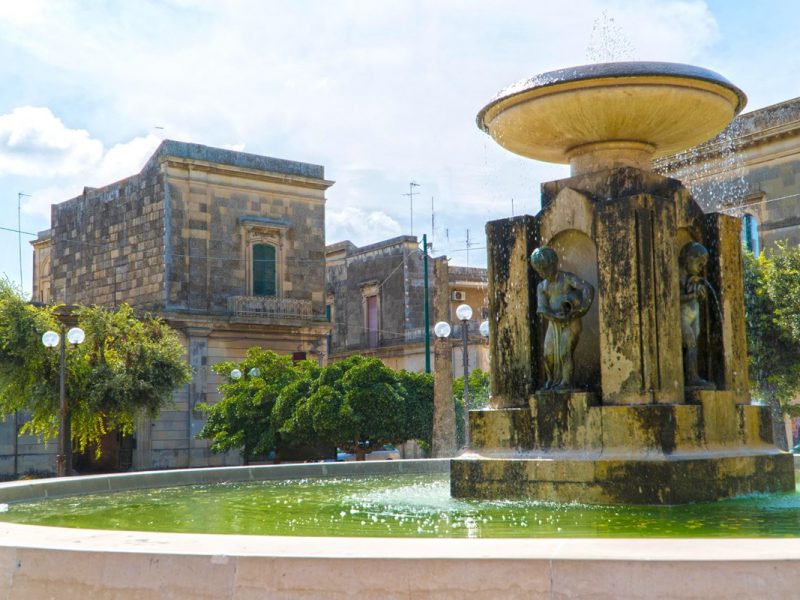The Borgo of Grottaglie
The potter’s wheel spins, busy hands covered in clay, the heat smoldering from the furnaces…Grottaglie is the town of artisan ceramics, a marvelous world of ancient tradition, sinuous forms and glowing colors.
In Grottaglie, the craft of ceramics is not only an art, it is the identity of a population, a population who knew how to receive a gift and render it fruitful. Earth and clay gave the gift of life: rendering it possible to construct the first houses, to create the first objects necessary for daily life, becoming the narrators of a story that began centuries ago and that continues on today, more alive and vital than ever.
Colorful hand-painted tiles render the main church vibrant and unique, ceramic lanterns hang from the balconies, their delicate glow illuminating the streets. The borgo is rooted in karst stone, built over ancient caverns that were once the dwellings of Prehistoric Man, which then became homes for the local inhabitants seeking refuge from the blood-thirsty Saracen Turks, and then hiding places for the “briganti” as they plotted for independence against the ruling nobles. These cave-homes, unique in all the world, are called “Le Gravine”, and are found only in Northern Puglia and Basilicata. They are masterpieces of stone created by man and nature, a spectacular world to admire and even listen to, in the area of Riggio, where the karst stone opens its heart and becomes a waterfall.
Grottaglie is teeming with life, born at the potter’s wheel and celebrated in the smiles of the people. Grottaglie is gratitude, but most of all, love, for what there is, and what is created.
History
Grottaglie is located in the furthest stretch of the Apulian Murge, a territory full of “Gravine”, karst stone caverns sculpted in the hillside by rainfall. These natural caverns provided comfortable shelter to pre-historic civilizations who began living in them in the Paleolithic period, furnished with a sufficient water supply and plentiful food for their livestock.
When the Muslim Saracens began their brutal assault on southern Italy, entire communities were forced to go into hiding to avoid being exterminated or taken into slavery. One community took refuge in the caverns in this territory, and in a short time created an urban center. Later, with the arrival of the Romans, canals and aqueducts were constructed, significantly improving the quality of life in the borgo. Unfortunately, with the fall of the Roman Empire and the successive Barbarian Invasions, Grottaglie suffered a long period of social and economic decline.
The Middle Ages marked the beginning of a slow resurgence for the borgo, which, according to a historical document, was attributed to an episode dating back to the IX century. In this period, the Normans relinquished the borgo, at the time called Cryptalearum, to the Archbishop of Taranto, initiating an economic influx of vast dimensions. Only later was it discovered that the document attesting this donation was probably false.
During the reign of the Bourbons, Grottaglie went through another difficult period. Power struggles between the ‘omnipotent’ local bishops and a various assortment of feudal lords continually wracked the borgo, the constant strife only definitively quelled with abolition of feudalism.
In the years of the Italian ‘Risorgimento’ movement, the borgo became a fulcrum for “briganti” activity, because of the perfect refuge provided by the city’s caverns. The “briganti” were local rebels, fighting against the exploitation of the common people by the ruling noble class.
Thanks to the ‘briganti’, Grottaglie began its first activity of urban expansion outside the city’s defensive walls.
With the Unification of Italy, Grottaglia’s immense historical heritage was almost entirely destroyed: the city walls, part of the Castle, the crests and ornate balconies of the noble palaces, even the main church underwent radical, unfortunate remodeling, eliminating some of its important historical elements. During this period, the city’s destiny was linked in misery to the neighboring towns, afflicted by unemployment, unhygienic living conditions, and a poor educational system.
With the advent of the 1900’s, Grottalie paid a high tribute in terms of human lives in World War I and II. Only after the Second World War did the borgo finally begin to experience economic stability and security. Grottaglie had finally found the key to transforming its principle commercial activities into the cornerstone for its economic and social rebirth, leveraging on its agriculture, premium vineyards, world class ceramics, and in recent years, a flourishing tourism industry. Today, thanks to this fulcrum of creative vitality, Grottaglie can proudly boast being one of the most populated and thriving towns in the province.
Il Castello Episcopio, The Bishop’s Castle
Even today, the Castle of Grottaglie represents the symbol of the temporal power the bishops of Taranto exercised over the city. The exact date of its construction is not documented, but we are certain that its original nucleus was already present in the XV century. This structure included the “Torre Maestra”, a tower inside the castle rising 28 meters with four independent floors, and the Bishop’s residence with an internal garden and terrace.
The ancient stalls no longer fulfill their original function and now lend themselves to celebrating Grottaglie’s traditional culture, as the site of the Museum of Ceramics. Every year, the Castle hosts two important exhibitions: the Ceramics Exhibition, and the Living Nativity Scene, displaying the city’s heritage of artisan masterpieces.
Differently from fortresses constructed for defensive purposes, the Castle, with its crenellated walls, was built as a noble home, probably for the Archbishop Giacomo dell’Atri. Over the centuries the structure has undergone numerous restorations and the exterior is now embellished with Baroque decor.
Chiesa la Collegiata Maria Ss.ma Annunziata, The ‘Mother’ Church.
The Archbishop Giacomo d’Atri commissioned the most important historical buildings in Grottaglie, one of these being the “Chiesa la Collegiata Maria SS.ma Annunziata”, known by everyone simply as the ‘Mother’ Church. It was constructed in 1372 in Late Romantic style, with a marvelous dome, or ‘cupola’, which enlivens the exterior with its colorful hand painted tiles in geometric designs. The façade is characterized by linear forms and elements, interrupted only by the large rose window and the central entrance which are decorated with garlands and flowers. This simplicity continues in the interior of the church, foregoing excessive decor to focus the accent on the important elements, such as the high relief of the Annunciation and the Chapel of San Ciro with the painting of the Madonna of the Rosary, attributed to De Matteis.
Museo della Ceramica, The Ceramics Museum
Grottaglie owes much of its fortune to its Ceramics Industry: an activity that has been the driving force of its economy for centuries.
Since the 1700’s, Grottaglie has been famous for its production of vases, bowls, religious objects, and especially its ‘Capasoni’, amphora of large dimensions used for transporting wine and oil.
In the year 1700, Grottaglie already had forty-two ceramics factories, recognizable by the smoke continually rising from their high chimneys. Today, this ancient tradition is a great source of pride for Grottaglie: the Ceramics quarter has become an important tourist destination, where you can still visit the traditional “botteghe”, or artisan workshops, to observe the master artisans laboring intently over their creations.
As you walk through the historical streets of Grottaglie, one building will surely catch your eye: the ‘Casa Vestita’, a place where time seems to stand still, but is actually still teeming with life and passion. Every year in this house, Mimmo Vestita hosts an exhibition of his ceramic creations, which he produces with his brother in their workshop in Via Santa Sofia. Mimmo and Carmelo are an indivisible team who, together, bring true masterpieces to life. Carmello works the clay, and Mimmo adds the unique decorative embellishments. The Vestita brothers set an example for this ancient land that is always seeking to valorize the gifts it has inherited, deftly implementing a recipe for success based on the perfect blend of three ingredients: perseverance, tradition and innovation.
In Grottaglie, the history of Ceramics and its very identity are inextricably linked, in a passionate love story that began thousands of years ago. To tell this story, the stalls of the ‘Castello Episcopio’ have been transformed into the Ceramics Museum. The Museum recounts every chapter of the history of this art, starting from the Prehistoric period all the way to contemporary ceramics: unique and original creations that have something for everyone, from amusing animals, to elegant design elements, from hand painted tiles to simple objects for everyday use, all narrators of the exceptional story of this borgo and its history.
Gravina di Riggio
The musical sound of water relaxes the soul, whether it is the soothing patter of falling rain outside your window, or the soft caress of waves gently lapping the shore. In Puglia, when you are inland and far from the sea, no one expects to hear it, the musical rhythm of water as it descends from the Karst boulders and forms a waterfall, the only waterfall in this land: the “Gravina di Riggio”.
This little corner of the world is visited only by those with a thirst for knowledge and discovery: it is not easy to reach, and without the help of a guide you might even get lost trying to find it.
Usually, the porous Karst stone of the “Gravine” absorbs water and drains it down into the depths of the earth. Only in Riggio do we find the exception to the rule, creating for Grottaglie a magical place of enchantment, where nature and biodiversity unite in perfect harmony with manmade constructions.
In these caverns, Prehistoric civilizations constructed complex cave villages around the natural water source, complete with a necropolis and places of worship, all conserved with the remarkable cave-paintings still intact.
The “Gravina di Riggio” is a truly unique place, and all you need to see it is the willingness to take a hike in the countryside near Grottaglie. But remember, don’t forget to wear your walking shoes!
“Donna baffuta sempre piaciuta” ‘A woman with a moustache is always liked’
Wandering through the ceramics workshops of Grottaglie, you will surely come across a curious object, a ceramic figure of a woman dressed in 17th century garb, with a moustache! This ‘donna baffuta’, mustachioed woman, is linked to a legend of Grottaglie. In Medieval times, there was a practice called Ius primae noctis, which gave the feudal lords of the borgo the right to lay with the newly married girls of the town on their wedding night. Whether this practice was actually carried out remains open for debate, but in the XVII and XVIII centuries, lecherous elements of the ruling class sought to “reinstate” it. Our legend, in fact, takes place in the 1700’s: a winemaker from Martina Franca had just married a girl from Grottaglie, who was going to be obliged to spend her wedding night with the ruling lord of the borgo, instead of with her new husband. The winemaker refused to tolerate this, and intent on saving his new bride’s honor, decided to dress up in elegant 17th century woman’s finery, and present himself at the dreaded ‘appointment’ in her place. When he arrived at the lord’s palace, there was just one problem, he had forgotten to shave off his mustache! The nobleman immediately saw through his disguise, and in a furious rage, sentenced the imposter to death. A few minutes passed, and once his initial anger had subsided, the lord suddenly burst out into hearty laughter, and upon learning that his “donna baffuta” was actually a winemaker, conceded that he would spare his life, but only if he brought his winery’s entire production of wine to the noble palace, carried in wine jugs shaped to represent the winemaker exactly as he was dressed that night, complete with mustache. The man took to the streets of the borgo, knocking on all the doors of the ceramics masters, asking them to create wine jugs, or amphora, in his likeness, as an elegant woman with a moustache. The whole town worked to help the winemaker, who was able to bottle his entire production of wine in seven hundred amphora.
Today, these figures of mustached women are one of the most prized ceramic objects produced in Grottaglie, and are made by only the most talented artisans. They can be found in all the artisan workshops in the borgo, sometimes in wonderful variations, such as the mustached Amazons.
Angelo Spagnulo
Born in Grottaglie, Angelo Spagnulo was a “carabiniere”, which in Italy is a type of policeman who is part of the military. You could say he was just a policeman, but he was much more. Angelo Spagnulo was someone who truly became a modern day hero, by making the ultimate sacrifice.
He was twenty five on the night of September 25, 2005, and twenty five he will always be. He had been in service in Verbania, in the north of Italy, but was on sick-leave for a foot injury, so he decided to return to his home town. That evening, he and his sister were in the town of Monteiasi, near Taranto, visiting their cousins who ran a café in a service station. It was a little after ten, when three masked armed robbers burst in and demanded all the cash from the register. When they heard that the earnings had already been deposited, they didn’t believe it and began to search frantically for the store safe. One of them jumped over the counter and pointed a gun at Angelo’s cousin. She was terrified, and without thinking twice, Angelo jumped up, even though he was wearing a cast, in an attempt to distract the robber who was threatening her. The robber responded by firing a spray of bullets at his head.
The ambulance came immediately and rushed him to the emergency room, but nothing could be done: Angelo Spagnulo died, after forty hours of agonized suffering.
His sacrifice was recognized at the highest level: “For having defended a young woman, even though he was off duty, unarmed, and ‘partially disabled”, Angelo Spagnulo was awarded the Gold Medal of Honor, and in 2010, the police station of the Carabinieri of North Taranto was named after him, in his memory.
Annibale Arces
Annibale Arces was born in Grottaglie in 1912. From a very young age he demonstrated a notable talent for drawing, which he continued to develop in the High School of the Arts.
His body of work includes still-lifes, landscapes, and portraits, executed as oil paintings or as “su tavolo”(an artisan technique of painting on wooden panels). In 1934 he began his career as a set designer, working at Cinecittà with the most important directors of the day. In 1946, after the Second World War, he transferred to Buenos Aires, where he worked in the grand theaters of the Argentine capital.
In 1956, he returned to Grottaglie where he continued to paint and also began to run the family business.
In 1986, Annibale Arces was awarded the “Premio Italia” by the Calvatone Accademia Italiana, and in 1989, the Giorgio Visari Award by the Istituto d’Arte Contemporanea of Milan.
In Grottaglie, he helped to found the fine arts institute, the “Scuola pittorica di Grottaglie”, offering an enormous contribution.
Annibale Arces passed away in Grottaglie in 1994.
“Lu cappucciu sittutu”- Il cavolo cappuccio seduto, The sitting cabbage
This typical dish of Grottaglie is prepared especially during the period of Lent, when the faithful often make a vow to give up a favorite tasty delicacy or give up eating meat.
Ingredients:
- A medium sized ‘cappuccio’ cabbage (a variety of cabbage);
- Three spoons of extra virgin olive oil;
- Three cloves of garlic;
- A dozen ‘a corona’ winter tomatoes (a variety of tomato);
- ‘Formaggio pecorino’ (Sheep cheese), as much as required.
Preparation:
Clean and wash the cabbage, place in a pot and boil with water and salt. In a terra-cotta casserole pan heat the oil and brown the garlic, then add the tomatoes, already peeled. Slowly add the cooking water from the cabbage to the terra-cotta pan, and cook at a moderate flame until you obtain a tomato sauce. Once the sauce is ready, add the cabbage and cover with a veil of grated pecorino cheese. Cover and leave for a few minutes before serving.

 Italiano
Italiano
 Deutsch
Deutsch

